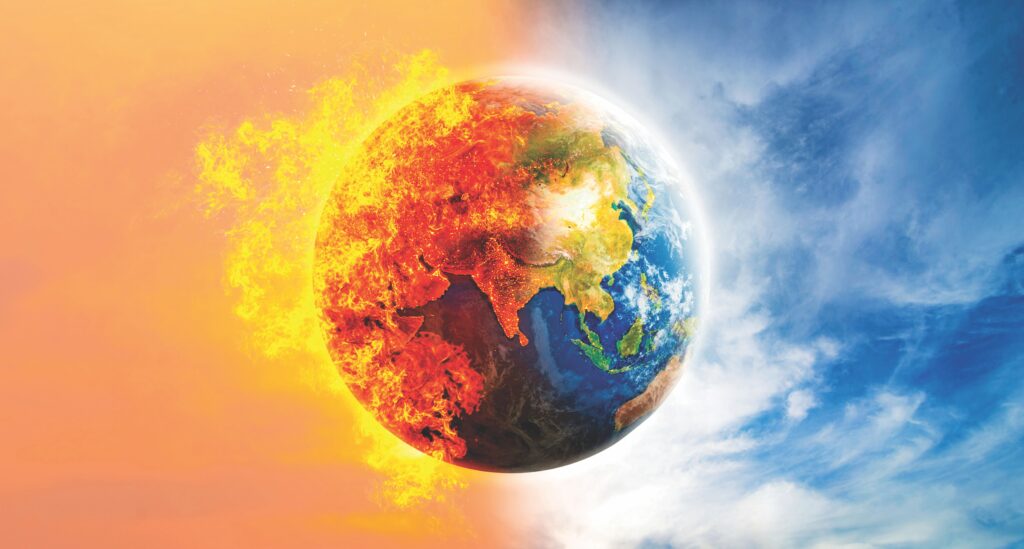Hotter and Hotter: Scientists have identified that heat can amplify the cancer-causing power of ultraviolet (UV) rays.
Surasak Suwanmake/Getty Images
As the world’s temperature rises, scientists say, so does our risk of skin cancer.
How weird has the weather been lately? Ask Miley Cyrus, who almost forfeited the thrill of getting her first Grammy when flooded roads in Los Angeles — that normally cloudless metropolis — delayed her arrival at the 2024 awards ceremony. “Oh my God, I got stuck in the rain and traffic and thought I was going to miss this moment,” she told a reporter. I watched the show from my home in a nearby canyon, where for the first time since moving here 15 years earlier, I’d had to stack sandbags against the doors as a precaution against rising waters.
But this is an article about skin cancer, so record-breaking downpours are not our primary meteorological concern. When it comes to extreme weather, what matters most to us is the kind associated with sunshine, and thus with ultraviolet (UV) radiation, the main environmental driver of skin cancers. We’re talking about heat. And whatever you believe is causing the escalation (most scientists blame human activity; about one-third of Americans disagree), the fact is that our planet is getting hotter.
Since 1880, when record-keeping first began, Earth’s surface temperature has risen by an average of 0.11 degree Fahrenheit per decade; since 1982, the rate has more than tripled, to 0.36 degree per decade. Last year was the warmest yet tallied, by a wide margin. “If you look at a graph, there’s a little bit of natural variability on the long-term trend,” says David Easterling, a climate scientist at the National Oceanic and Atmospheric Science Administration. “But the trend is very definitely going up, and it’s accelerating.”
Of course, not all sunny days are hot, and not all hot days are sunny. Yet a growing body of research shows that heat and sun can work together to increase skin cancer risk. That happens in two principal ways — one stemming from our behavior, and the other from biological processes invisible to the naked eye.
Factor 1: More Heat Drives Greater UV Exposure
The behavioral component is straightforward: When the weather is warmer, people do things that expose them to more sunlight. “As temperatures rise, we wear less clothing,” notes Shawn Allen, MD, a dermatologist in Boulder, Colorado. “And in areas where cold weather used to keep us inside all winter, we’re spending more time outdoors during that season.”
Sweat, Dr. Allen adds, can act as a lens, amplifying the effect of UV radiation on the skin. It can also lessen the effectiveness of sunscreen, assuming folks bother to wear it. “People are less conditioned to put on sunscreen in the winter months, or when the sky is overcast,” he says. “They stay out longer than they should, because they have a false sense of security.”
In part, that complacency may stem from the fact that there are two kinds of UV radiation, and UVB, the type that causes sunburns, is less prevalent in winter and on cloudy days. But UVA radiation, which reaches deeper layers of the skin, is plentiful year-round, and it easily penetrates cloud cover. Studies suggest that frequent sunburns caused by UVB lead to higher risk of melanoma, the most dangerous type of skin cancer, while cumulative damage from both versions of UV raises the risk of the more common basal cell carcinoma (BCC) and squamous cell carcinoma (SCC).
This helps explain why residents of northern states have higher rates of melanoma: After a chilly winter (even if it’s less frosty than in times past), people want to spend time baking in the open air. “The culture in those regions is that every summer you get sunburned,” says dermatologist Carsten Hamann, MD, who did his training in New Hampshire. “In areas that are warm year-round — like Phoenix, where I practice now — everyone gets lots of sun, but that episodic, high-dose UV exposure is less common. So we see plenty of skin cancer, but fewer melanomas.”
Factor 2: More Heat Can Amp up UV’s Damaging Effects
The biological links between heat, UV radiation and skin cancer risk are more complex. Since the 1940s, animal and human studies have suggested increased rates of UV-induced tumor formation at higher temperatures. And over the past decade, scientists have identified synergistic relationships between heat and UV on the cellular level.
One key mechanism, Australian researchers found, involves a process known as cell-death signaling. Under normal conditions, skin cells whose DNA is damaged by UV radiation kill themselves before they can reproduce. But when cells experience heat stress, they produce proteins that inhibit the “self-destruct” signal, enabling more damaged cells to survive. That, in turn, can amplify UV’s cancer-causing power.
Those microscopic processes also interact with other environmental forces — particularly, the ongoing depletion of Earth’s ozone layer. Ozone is a gas that occurs naturally in the upper atmosphere, where it blocks a portion of UVB rays from reaching us down below. In 1985, researchers discovered a huge hole in the ozone layer over the Southern Hemisphere and realized that it was thinning elsewhere as well. The damage, they determined, was caused largely by volatile compounds known as chlorofluorocarbons, then used as refrigerants and aerosol propellants.
An international treaty signed in 1987 called for phasing out production of those chemicals, and ozone depletion has since slowed significantly. It won’t stop anytime soon, though, climatologists say, because new weather patterns are further damaging the ozone layer. Another impediment: increasing emissions of methane, a common byproduct of fossil fuel production and other human activities, which, like those banned chlorofluorocarbons, is not only a heat-trapping “greenhouse” gas but also destroys ozone. “Best-case scenario, recovery may start around 2060,” says Eva Parker, MD, an assistant professor of dermatology at Vanderbilt University. “So it’s still decades away.”
Meanwhile, more UVB is reaching us through the thinning shield of ozone, a major reason skin cancer rates continue to rise around the world. (In the U.S. alone, the number of invasive melanoma cases diagnosed annually increased 32 percent from 2014 to 2024.) And behavioral and biological factors driven by global warming seem to be exacerbating the trend.
There’s yet another way the planet’s rising fever may contribute to the uptick in skin cancers: By sparking more wildfires. According to the Environmental Protection Agency (EPA), the area burned by fires in the U.S. each year has increased in parallel with global temperatures, from about a million acres in 1983 to 10 million in 2020; fire seasons have been lasting longer, too. The particulate matter produced by these blazes is “very sticky,” Dr. Parker explains. Glommed onto it are carcinogenic substances such as heavy metals and polycyclic aromatic hydrocarbons, which can be absorbed through our skin — potentially exacerbating the effects of UV radiation.
“This is not to say that rising rates of skin cancer are solely due to climate change,” adds Dr. Parker, who authored a landmark 2021 paper in The International Journal of Women’s Dermatology mapping the connections between the two phenomena. “The problem has many contributors, including skin type, genetics and immune status. But we know heat can accelerate carcinogenesis in the skin. We know UV is bad and air pollution is bad. All those things acting together could be even worse.”

Bronze Ambition: Despite all the warning signs, people still like to tan. Tanning hashtags get millions of views and likes on social media.
David Lees/Getty Images
Cool Advice for Hot Times
For anyone trying to ward off skin cancer in a warming world, it’s increasingly crucial to factor these heat-related threats into our defensive strategy. To begin with, dermatologists’ old refrains about sun protection (and sun avoidance) have taken on new urgency. “Everyone should be wearing sunscreen,” says Dr. Hamann. “It should be part of your daily routine: You brush your teeth and put on sunscreen.” If you have an outdoor hobby, reapply every two hours, or after swimming or sweating. And try to avoid high UV time. When you take a walk, do it before 10 AM or after 4 PM.
Such precautions, experts say, should also take your location into account. “UV levels increase about 2 percent for every 1,000-foot increase in elevation,” says Dr. Allen, who regularly excises skin cancers from sun-wizened mountaineers in his mile-high Boulder office. “Skiers and climbers can get extra exposure from sunlight reflecting off the snow or ice.”
Dr. Parker offers even more granular advice. “Skin is our primary interface with the environment,” she says. “So before exercising outdoors, you should check not only the temperature and UV index but the air quality. If it’s a bad-air day, exercising indoors might be healthier for your skin as well as your lungs. And when you do go out for a walk or a run, even if you stay mostly in the shade, it’s a good idea to wear a hat and sun-protective clothing. The more your skin is covered, the less air pollution is contacting it.” Those tips, she adds, are especially important for people who are immunocompromised or have conditions such as vitiligo, which can increase their vulnerability to skin cancer.
But not everyone has the luxury of making such choices, Dr. Parker observes. Low-income and minority communities are often situated in urban heat islands — areas that have few trees and lots of concrete, making them several degrees warmer than more prosperous neighborhoods. Residents often can’t afford air conditioning, and many work in occupations, such as construction or farm labor, that require them to be out in the sun (and, perhaps, particulate-laden air) all day. The World Health Organization, she points out, recently published a study showing that one in three deaths from nonmelanoma skin cancer occur in outdoor workers.
For all these reasons, Dr. Parker suggests, reducing skin cancer rates may require us to look beyond saving our own skins. “If we’re serious about fighting this growing health crisis,” she says, “we need to think about what we’re doing to the planet.”
Kenneth Miller is a Los Angeles-based journalist. His book, Mapping the Darkness: The Visionary Scientists Who Unlocked the Mysteries of Sleep, was published in October 2023.




